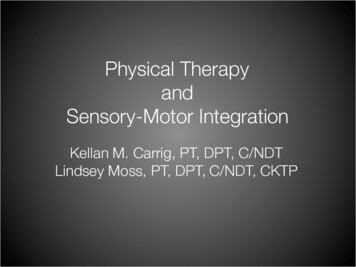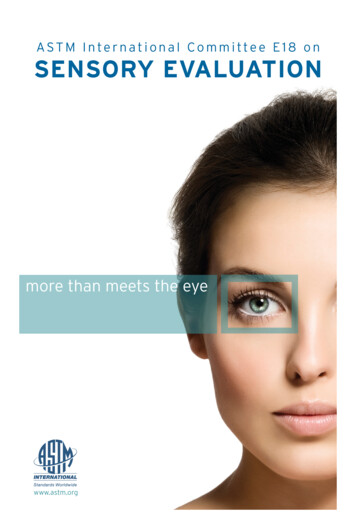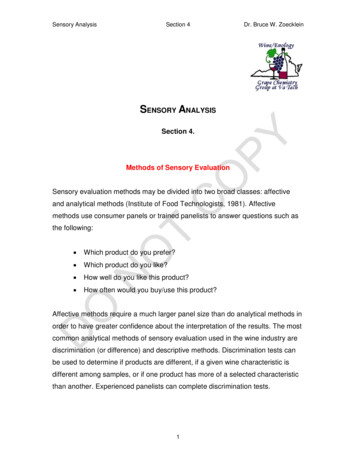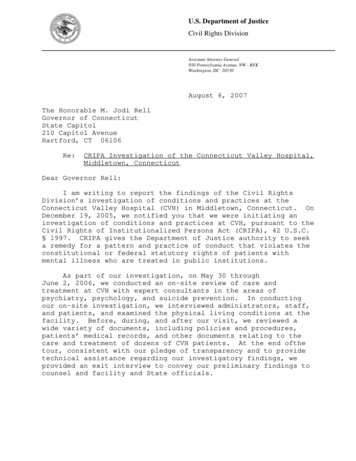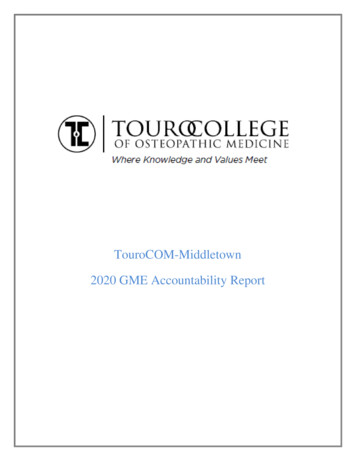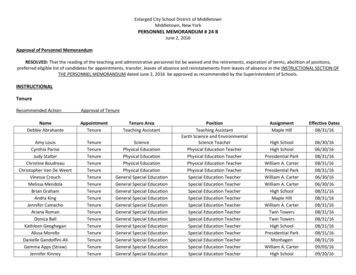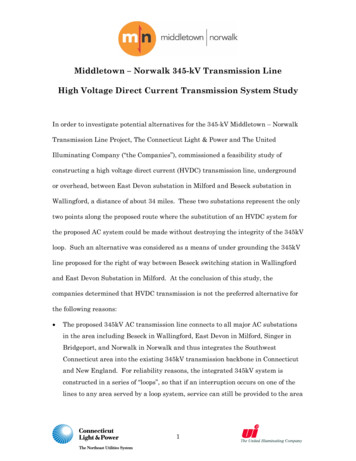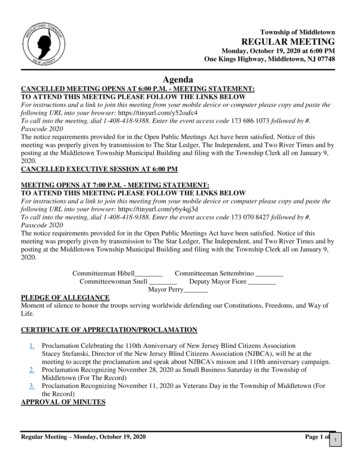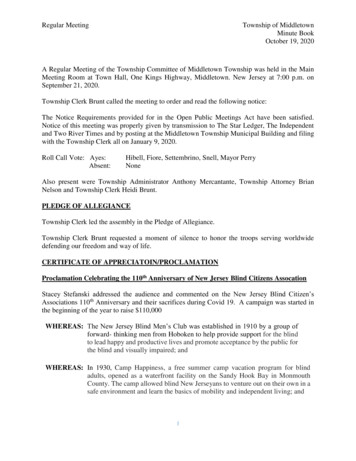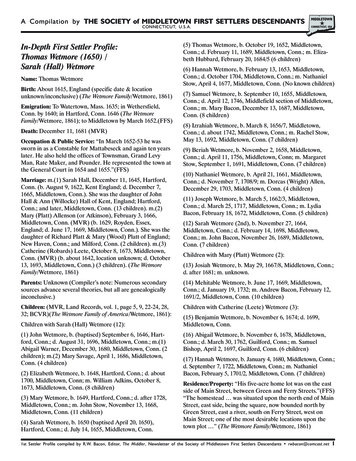
Transcription
Sensory ProcessingVolume 2Research Bulletin Issue No. 26July 2018
Sensory Processing Volume 2ContentsIntroduction5Interview with Professor Kelly Mahler6Research Articles Summarised111.Meal Time Behaviour Difficulties but not Nutritional Deficiencies Correlate with SensoryProcessing in Children with Autism Spectrum Disorder2.Auditory Processing and Sensory Behaviours in Children with Autism Spectrum Disorders asrevealed by Mismatch Negativity3.Brief Report: Assessment of Early Sensory Processing in Infants at High-Risk of AutismSpectrum Disorder4.The Relationship between Sensory Processing and Anxiety on CARS Scale in Autism SpectrumDisorder5.Sensory Over-Responsivity and Social Cognition in ASD: Effects of Aversive Sensory Stimuliand Attentional Modulation on Neural Responses to Social Cues6.Sensory Processing in Autism Spectrum Disorders and Fragile X Syndrome – From the Clinicto Animal Models7.Sensory Reactivity, Empathising and Systemising in Autism Spectrum Conditions and SensoryProcessing Disorder8.Behavioural, Perceptual, and Neural Alterations in Sensory and Multisensory Function inAutism Spectrum Disorder9.Sensory Processing in Children with Autism Spectrum Disorder: Relationship with Non-VerbalIQ, Autism Severity and Attention Deficit/Hyperactivity Disorder Symptomatology10.The Design and Implementation of a CBT-Based Intervention for Sensory ProcessingDifficulties in Adolescents on the Autism Spectrum11.A Systematic Review of Sensory Based Autism Subtypes12.The Interplay between Sensory Processing Abnormalities, Intolerance of Uncertainty, Anxietyand Restricted and Repetitive Behaviours in Autism Spectrum Disorder13.Assessing Sensory Processing Dysfunction in Adults and Adolescents with Autism SpectrumDisorder: A Scoping Review14.The Impact of Atypical Sensory Processing on Social Impairments in Autism Spectrum DisorderConclusion433
Sensory Processing Volume 2INTRODUCTIONThis is the twenty sixth Research Bulletinproduced by Middletown Centre for Autismand it provides summaries of fourteen articlesspanning from 2014-2017.The Bulletin commences with an interview withProfessor Kelly Mahler.Professor Kelly Mahler is a parent, occupationaltherapist, author, speaker and AdjunctProfessor of Occupational Therapy. She earnedan MS in Occupational Therapy, as well as aPost-Professional Pediatric Certificate fromMisericordia University, Dallas, PA. As anoccupational therapist and autism consultantshe supports school-aged individuals and youngadults with autism.Kelly is co-founder of Destination Friendship,an organisation providing fun opportunitiestargeted at developing friendship skills in youngpeople with autism. She is also actively involvedin multiple research projects pertaining tointeroception. Kelly has presented numerousseminars and workshops at the internationaland national levels.Kelly has authored many books including: Interoception: The Eighth Sensory System The Comprehensive Assessment ofInteroceptive Awareness Sensory Issues and High Functioning Autism(with Myles and Robbins) - winner of NationalParenting Publications Bronze Medal Destination Friendship: Developing SocialSkills for Individuals with Autism SpectrumDisorders or Other Social Challenges (withBenton, Hollis, and Womer) Hygiene and Related Behaviors for Childrenand Adolescents with Autism Spectrum andRelated Disorders - winner of Mom’s ChoiceAwards Gold Medal.Please note that the views represented in this documentdo not necessarily reflect the views of MiddletownCentre for Autism. Reviewers have, where possible,used the original language of the article, which maydiffer from UK and Ireland usage and the usage of arange of terminologies for autism.5
6Sensory Processing Volume 2Middletown Centre for AutismAN INTERVIEW WITHPROFESSOR KELLY MAHLER1. A young person with autism’s sensoryexperience of the world can have aprofound effect on their life. Asprofessionals how can we help tosolve these difficulties within theclassroom/school environment?I believe one of the best solutions that we can useas professionals is to proactively provide a sensoryfriendly school environment. Learn about eachyoung person and his or her unique sensoryneeds. Try to consider these sensory needsthroughout the school day and implementmodifications that will maximise sensorycomfort. For example, if you know a student isvery sensitive to sounds, keep this in mind withinthe classroom by reducing any backgroundnoises, using a teaching approach that is low andslow, and providing advanced notice if any loudnoises or activities are planned for the day (e.g.fire drills, assemblies, class party, etc).Additionally, when the student is calm, worktogether to create a plan, outlining steps thestudent can follow when the sensory environmentbecome ‘too much’. Keep in mind that the youngperson may not always recognise the feeling ofsensory overwhelm, so account for this in theplan by adding in a secret signal that the studentwants the teacher to use.2. Why do a young person’s responsesto particular sensory experiencesfluctuate from one day to the next?4. What is stimming and why do manyyoung people with autism engagein stimming?As with all of us, the ability to tolerate sensoryexperiences fluctuates with a variety of factorsincluding our levels of stress, how much we sleptthe night before or how predictable the situationis at hand. A young person with autism is nodifferent. When a young person is stressed, sleepdeprived or in an unpredictable situation, theability to tolerate sensory experiences goes down.Stimming, which is short for self-stimulatorybehaviour, is usually a repetitive behaviour ofsome form like flapping hands, body rocking,spinning a string round and round, jumping upand down, pacing back and forth, or makingrepetitive vocalisations. Autistic people reportthat stimming is very soothing and calming (infact, sometimes it is the only strategy that helpsthem feel calm in an otherwise overwhelmingenvironment).3. In your opinion, what are the mostaccessible interventions supportingchildren and young people withsensory processing difficulties?With the advances in technology, and havinginformation at our fingertips, many interventionsare fairly accessible. Most people, including ayoung person with sensory processing difficultiescan virtually find countless techniques to useto modify the sensory environment and maximisecomfort.5. Should stimming be encouraged orprevented in school?Encouraged. As long as the stimming is safe anddoes not put a student at risk of injury. In mostcases, stimming can be one of the most powerfulmethods that a student can use to get them readyand engaged in the learning process. I always findit strange when I see behavioural programmesdesigned to reduce the frequency of (safe)stimming. In other words, these behaviourprogrammes are designed to reduce the frequencyof the individual using a calming strategy! Thatdoes not make much sense.6. Could you explain the eighth sense‘interoception’, and what impacthaving difficulties with interoceptionmight have on a young personin school?Interoception is a sensory system that allows us tosense or feel our internal body signals. Thesesignals often come from body areas that manytimes we can’t see, but we can still feel them. Forexample, we are able to feel our stomach growl,our heart speed, our throat grows dry and ourmuscles tense because of interoception. Thesesignals are important to our emotionalexperience. When we clearly feel the signals fromour body, they become clues as to what emotionwe are experiencing. For example, when you feelyour heart race, your stomach flutter and yourmuscles shake you know you are scared. Or whenyou feel your muscles tighten, your breathinggrows shallow and your voice grumble you knowyou are frustrated. Or when you feel your eyesgrow heavy, your muscles are sluggish, and yourbrain is foggy, you know you are tired.Interoception is the foundation of this bodyemotion connection.7
8Sensory Processing Volume 2Middletown Centre for Autism7. How are anxiety, emotionalregulation difficulties and sensorydifferences linked?You have to notice and understand exactly howyou feel in order to manage it effectively. Whenwe are able to clearly notice body signals, andconnect the body signal to the correspondingemotion, this urges us into action. Interoceptionserves as our motivation to seek out comfort in atimely manner. For example, if you notice apounding heart, fast brain and shaky muscles andknow these body signals mean you are anxious,you are urged to do something to restore thecomfort in your body (e.g. go for a walk). When aperson has interoception difficulty, it can result inan unclear body-emotion experience. Challengesin figuring out how you feel, can lead to greatdifficulty managing your emotions. Cheyanne, ayoung person with autism shared, “I would notrealise I was anxious until I was in a fullmeltdown, hiding in a corner or under a table. Ididn’t notice the anxious feelings building in mybody.” Max, another young person with autismshared, “Teachers at my school would get upsetwith me because I didn’t use my ‘emotion tools’when I was anxious. The problem was that I nevernoticed the need to use my ‘emotion tools’ – Inever noticed that I was anxious until it was waytoo late.”8. How can sensory knowledge andstrategies improve anxiety/mentalhealth/wellbeing, for individualswith autism?In terms of interoception, becoming more awareof your body and emotions can have a drasticeffect on mental health and wellbeing. It gives aperson more power to manage the way they feel.Exploring and understanding sensory needs ingeneral can also have a profound effect on mentalhealth and allow a person to communicate needsto others and seek out strategies for reducingsensory discomfort.9. Top tips for improving/regulating ayoung person’s connection with theirsense of interoception?To improve interoception, we need to improve theability to notice and understand internal bodysignals, thus building body-emotion connections.Many of the interventions that my colleagues andI have developed are influenced by mindfulness,which is currently the only evidenced-basedtechnique for improving interoception. However,because mindfulness is extremely abstract formany young people, including children withautism, we took mindfulness-based strategies andmade them very concrete, systematic and visual.We have an Interoception Curriculum comingout in October 2018 that will include thesestrategies as well as a step-by-step guide toimproving interoception. For free informationabout interoception, check out www.mahlerautism.com or join our Facebook GroupInteroception: The Eighth Sensory System.10. Some young people with sensoryprocessing difficulties experiencedifficulties with hygiene. What generaladvice would you give families forimproving personal hygiene skills?Improving personal hygiene is largely trial anderror, exploring a variety of ways to adapt hygienetasks to make them as sensory comfortable aspossible. Use input from the young personwhenever possible. One of my young femaleclients just went to the local store with her fatherto find a brand of shampoo she would be willingto use. They sat in the shampoo aisle for an hourand smelled each one until they found one shewould try. You have to be willing to be flexibleand creative to adapt the hygiene for the youngperson. However, it is also important to teach the‘whys’ behind good hygiene, provide the logicalreasons why good hygiene is so important.9
Sensory Processing Volume 2Meal Time Behaviour Difficulties but notNutritional Deficiencies Correlate withSensory Processing in Children withAutism Spectrum DisorderBACKGROUNDRESEARCH AIMSIn addition to atypical behaviours at meal time,specific dietary habits and preferences arerecognised as behavioural criteria for thediagnosis of children with autism. Due to atypicalbehaviours at mealtime there are concerns aroundthe possibilities that this may be the cause ofnutritional deficiencies.To offset the household confounder this studyaimed to explore the feeding difficulties ofchildren with autism compared to their siblingswho live in the same household and as well aswith other typically developing children. Anotheraim of this study was to evaluate the associationsbetween mealtime behaviour, nutritionaldeficiencies and sensory profile in childrenwith autism.There are many studies that support the presenceof feeding difficulties in children with autism(food refusal, PICA disorder, limited variety offoods, food preparation preferences, rejecting/preference for food; oral motor difficulties).Regarding nutritional difficulties there are manycase study reports of children with autismexperiencing a range of medical difficulties(scurvy, rickets, vitamin A deficiencies). Inaddition to nutritional deficiencies, research hasalso indicated that some children with autismmay have a preposition to be overweight.Behaviours related to meals have also been linkedto sensory processing difficulties (sensitivities totextures, smells, colours, taste of food or differentbehaviours around mealtimes that may be linkedto senses) in children with autism, resulting inheightened anxiety in relation to nutritionalconsequences which in turn results in more stressat mealtimes.The authors in this study highlighted that someof these prior findings may be confounded byhousehold preferences.RESEARCH METHODA total of fifty children with autism, aged three tosix years, were compared in a case control studyto their typically developing (TD) siblings (agedbetween three and 12 years) and a TD controlgroup, matched by age and gender.Exclusion criteria was applied for participationamongst all groups whereby children were notincluded in the sample if they used foodsupplements, had a metabolic disease such asdiabetes mellitus or celiac disease or followeda gluten-free or casein-free diet.11
12Sensory Processing Volume 2Middletown Centre for AutismMeasures usedQuestionnaires - the Autism ScreeningQuestionnaire was used to screen childrenwith autism.Weight, height and body mass index (BMI) wasreported by parents with comparative measuresusing the Wirkd Health Organisation AnthroPlussoftware between each of the three groups inthe study.Demographic variables were collected using aself-administered questionnaire.Nutritional consumption was obtained by parentsusing a self-administered semi-quantified fooddiary to record the quantity of food consumed inreal time. Parents were instructed to complete twoweekdays and one weekend day using a foodguide developed by the Department of Nutritionof Public Health Services in the Israeli Ministry ofHealth. A registered dietitian reviewed the dietrecords immediately after data collection withnutrient consumption calculated using a specificdietary programme.Behavioural problems during lunchtime - BAMBIquestionnaire consisting of 18 items scored on a5-point Likert scale was used to measure thefrequency of mealtime behaviour problemsunique to children with autism. The questionnaireis defined by a 3-factor structure: limited variety,food refusal and features of autism.Sensory profile - this questionnaire was completedonly by the autism group. The Sensory ProfileCaregiver Questionnaire was completed only bythe autism group. The questionnaire is a 125 itemquestionnaire, used among 3-10 year olds. Thequestions in this questionnaire are scored on a5-point Likert scale, and may ask parents if theirchildren behave in certain ways to sensorystimuli. Results from this measure are analysed inseveral ways:1. Nine factor groupings characterising childrenby their responsiveness to sensory input,sensory seeking, emotional reactive, lowendurance/tone, oral sensory sensitivity,inattention/distractibility, poor registration,sensory sensitivity, sedentary and fine motor/perceptual.2. Three sections quantify the ability to respondto sensory processing, modulation,behavioural and emotional responses.3. Quadrants measure the degree to whichchildren miss, obtain, detect or are botheredby sensory input.FINDINGSResults from this study indicated that mealtimebehaviour difficulties were significantly moreprevalent in the group of children with autismcompared to their siblings and the TD controlgroup. These differences were associated with arange of sensory regulation difficulties as opposedto nutritional deficiencies, with householdpreferences having limited effect on food aversionscores of children with autism.With regard to whether children who experiencemore difficulties during mealtime would displaymore nutrient deficiencies, results indicated asignificant correlation for “features of autism” andthe nutrient deficiencies. Findings furtherindicated that difficulties around mealtimesgreatly influence the life of families of childrenwith autism. Significant differences between theBAMBI results over the SP factors, sections andquadrants indicate that there are greaterchallenges for children with autism who expressnon-typical sensory processing at meal time.IMPLICATIONS FOR PRACTICE(by the authors)Understanding that part of the difficultieschildren with autism display during meal timemay be due to sensory issues is an importantfactor in building appropriate treatment andintervention for the child and their family.The lack of differences between nutritionaldeficiencies over the SP factors, sections andquadrants from this study further indicated thatchildren who are at nutritional risk are notnecessarily those who display unusual reactionsto sensory stimuli.The authors also posit that children with autismwho are less picky or whose parents might noticeless atypical behaviours at mealtime, may havenutritional deficiencies, so it is also importantthat these children are also evaluated.Furthermore, taking into consideration theincreased nutritional risk and the lack ofpredictive tools which are adequate to assess forrisk, it is evident that these children will benefitfrom a comprehensive assessment. This shouldinclude a nutritional assessment in addition to anappraisal of sensory aversions and preferences.Full ReferenceShmaya, Y., Eilat-Adar, S., Leitner, Y., Reif, S. andGabis, L. V. (2017). Meal Time BehaviourDifficulties but not Nutritional DeficienciesCorrelate with Sensory Processing in Childrenwith Autism Spectrum Disorder. Research inDevelopmental Disabilities, 66, p. 27-33.13
14Sensory Processing Volume 2Middletown Centre for AutismAuditory Processing and Sensory Behavioursin Children with Autism Spectrum Disordersas revealed by Mismatch NegativityBACKGROUNDProblems in auditory processing are a commonlyreported sensory processing difficulty amongstchildren with autism. Examples of atypicalresponses to auditory stimuli may include thechild with autism placing their hands over theirears or having a preoccupation with a specificnoise within the environment. Whilst muchresearch has considered the differences betweenspeech and non-speech stimuli, limited attentionhas been directed towards the influence ofsemantic content of the stimuli employing amismatch negativity (MMN) task.RESEARCH AIMSThe current study aimed to examine whetherchildren with high functioning autism wereimpaired in auditory discrimination of speechsounds using a MMN paradigm using words andpseudowords.RESEARCH METHODSEleven boys with an autism spectrum disorderaged 11-16 years were matched for verbal andnonverbal IQ with eleven typically developingboys to participate in a MMN model. Childrenwere recruited through local mainstream schools.Parents provided confirmation that their childrendid not have any hearing problems or anypsychopathological or neurological disorders.Clinical and behavioural data was collected fromall children using the Adolescent/Adult SensoryProfile Questionnaire, the Edinburgh HandednessQuestionnaire, nonverbal IQ based on the RavensMatrices and verbal IQ using the British PictureVocabulary Scale.After psychometric testing the childrenparticipated in a mismatch negativity (MMN)task. During this task children were situated in avideo-controlled, electrically shielded and soundproofed space. Stimuli was delivered viaheadphones, whilst watching a silent movie oftheir choice; they were instructed to ignore anyincoming acoustic stimuli. During this activity,two refreshments breaks were provided. Electricalbrain activity was recorded throughout theexperiment. Overall the experiment lasted30 minutes.FINDINGSResults from this study indicated that childrenwith autism displayed significantly reduced MMNresponses to speech like stimuli (i.e. both wordsand pseudowords) in the frontal regions of thebrain, compared to typically developing children.This effect was more pronounced between groupsacross the meaningful stimuli as children withautism displayed reduced activation in both thefrontal and central regions of their brains forwords. Differences for pseudowords werehowever only identified in the frontal regions ofthe brain. These findings correlated with previousstudies which suggest that children with autismhave an altered functional connectivity,prominently in the frontal cortex and circuitslining frontal areas to other brain systems.In relation to whether auditory sensoryprocessing is relevant to the way words areprocessed compared to pseudowords it was foundthat auditory responsiveness was the mostcommon and pervasive form of sensorybehaviour amongst children with autismcompared to the neurotypical group.Furthermore, to identity whether auditorysensory processing was a moderator of thedifferences in the way words and pseudowordswere processed, findings revealed that as sensorysensitivity scores increased for children withautism, the lower their amplitude for words, withsensory sensitivity appearing to be the strongestsensory moderator of this effect.Furthermore, auditory sensory scores collatedfrom the Adolescence Sensory Profile indicatedthat children with autism recorded significantlyhigher behaviours to auditory stimuli thantypically developing (TD) children across three ofthe sensory quadrants (Low Registration,Sensation Seeking, Sensation Sensitivity, andSensation Avoidance).IMPLICATIONS FOR PRACTICE(by the authors)Although this study has indicated that sensorybehaviours may underlie differences in auditoryperception of speech-like stimuli in children withautism, the authors have highlighted that resultsfrom this study should not be generalised tosituations when meaningful stimuli is mixed withmeaningless noise which occurs within mostsocial situations, nor should comparisons bemade when children with autism are explicitlyrequested to attend to speech-like stimuli.Also, as children with autism were recorded tohave significantly higher behaviours to auditorystimuli than TD children further research isrequired to address the interactions between thedifferent auditory sensory measures in addition tobearing in mind the impact of sensorycommonalities such as vision and tactile.Full ReferenceLudlow, A., Mohr, B., Whitmore, A., Garagnani,M., Pulvermüller, F. and Gutierrez, R. (2014).Auditory Processing and Sensory Behaviours inChildren with Autism Spectrum Disorders asrevealed by Mismatch Negativity. Brain andCognition, 86, p. 55-63.15
16Sensory Processing Volume 2Middletown Centre for AutismBrief Report: Assessment of Early SensoryProcessing in Infants at High-Risk of AutismSpectrum DisorderBACKGROUNDRESEARCH METHODSFollowing a systematic review of the literature, itis acknowledged that atypical sensory responsesare frequently reported in children with ASD incomparison to typically developing children,although by itself, these sensory symptoms do notdifferentiate ASD from other disabilities. Thesesensory symptoms could be informative in theearly detection of ASD as the sensory modulationand regulation behaviours of toddlers with ASDhas been reported as significantly different tothose without ASD.The ITSP was administered at 24 months to assessa range of sensory inputs as described by parents.It assesses sensory processing across five areas:auditory, visual, tactile, vestibular and oral. TheITSP also assesses the child’s reaction to a sensoryexperience within four quadrants: lowregistration, sensory seeking, sensory sensitivityand sensation avoidance. Diagnostic assessmentat three years, using the Autism DiagnosticObservation Schedule (ADOS) and the AutismDiagnostic Interview (ADI-R), was conducted bya psychometrist, psychologist or developmentalpaediatrician trained to research reliability, whowas not aware of any previous study assessments.A total of 91 participants gave complete data, 31LR and 60 HR (15 HR-ASD; 45 HR-N).The Infant/Toddler Sensory Profile (ITSP) is themeasurement framework used to evaluatetoddlers’ behavioural responses to sensory stimulias observed and reported by parents. In aprevious study, Mulligan and White (2012), usedthe ITSP to compare 13 high-risk (HR) infants(they had an older sibling with ASD), againstnormative ITSP data. The results showed that theinfants had less sensory-seeking behaviours. Asthis study was conducted on infants before theywere diagnosed and did not follow through oncethe diagnostic outcome of those infants wasdetermined, it was unclear from the studywhether the differences found were relatedto ASD.RESEARCH AIMSThe aim of this study was to compare 24-monthITSP scores among three groups based on theirdiagnostic outcomes at three years. The groupwere (a) a HR group who were later diagnosedwith ASD (HR-ASD), (b) a HR group who werenot later diagnosed (HR-N) and (c) a low-riskgroup of infants with no first-degree familyhistory of ASD (LR). It was hypothesised thatthere would be significant differences among thethree groups with the parents of the HR-ASDgroup reporting the highest number ofsensory differences.RESEARCH FINDINGSThe results showed significant differencesregarding auditory processing, with the HR-ASDgroup mean score being significantly higher thanthe HR-N and LR groups. There were nodifferences detected in the scores for visual,vestibular, tactile or oral sensory processing. Inthe quadrant scores, there was a significant groupdifference obtained for low registration (e.g. doesnot notice sensory stimuli), where again the meanHR-ASD score was significantly higher than theother two groups. This is not specific to a certaintype of sensory domain but rather indicates theoverall behaviours of the toddlers to a range ofsensory inputs. There was also a non-significanttrend that showed that the HR-ASD wouldengage in sensory seeking behaviour (e.g. seekingout a sensory stimulating environment).IMPLICATIONS FOR PRACTICE(by the author)Clinicians:Although the hypothesis was only partiallysupported by the findings, the identification ofsensory differences in terms of auditoryprocessing and low registration to all types ofsensory domains, could be potential risk markersof ASD amongst HR toddlers. The ITSP did notidentify differences in other sensory areas. Butthey are sometimes reported to clinicians inyoung children with suspected ASD. Directclinical observation and/or objective laboratorybased sensory measures could be used inconjunction with the ITSP to provide multipleperspectives for identifying ASD in youngchildren. The authors recommend exploring thelink between temperament and sensoryprocessing to identify differences in HR infantsfor ASD.Researchers:Although the sample size was larger than inprevious reports it was still relatively small. Futurestudies should be larger and could includeexamining sensory profiles for children with ASDusing symptom levels and functional abilities asthe basis for understanding whether sensorydifferences correlate with the severity of thesedimensions. It is important to identify whethersensory processing differences exist between HRinfants and infants with other developmentaldisabilities to increase the use of the ITSP intoother areas. This study has contributed additionalinformation on the sensory differences that couldforecast ASD in an HR cohort, there is furtherneed to examine whether these findings can begeneralised to children with a family history.Due to the HR parents all being second timeparents, it could be assumed that they would bemore aware of their child’s development giventheir experiences and so their responses may bemore reliable than first time parents.Full ReferenceGermani, T., Zwaigenbaum, L., Bryson, S., Brian,J., Smith, I., Roberts, W., Szatmari, P., Roncadin,C., Sacrey, L. A. R., Garon, N. and Vaillancourt, T.(2014). Brief Report: Assessment of Early SensoryProcessing in Infants at High-Risk of AutismSpectrum Disorder. Journal of Autism andDevelopmental Disorders, 44, p. 3264-3270.17
18Sensory Processing Volume 2Middletown Centre for AutismThe Relationship between SensoryProcessing and Anxiety on CARS Scalein Autism Spectrum DisorderBACKGROUNDRESEARCH FINDINGSChallenges with sensory processing have alwaysbeen associated with autism spectrum disorders(ASD) but it is only since DSM-5 (2013)that sensory problems were classified as acrucial symptom.The CARS results were processed on the sampleof 42 participants, of whom 32 were male and 10were female. The average age of those selected was23.81, with the youngest being 16 and the oldest35. The level of intellectual ability ranged frommild to profound mental retardation. The meanscore of the scale, which determines the degree ofthe autistic disorder, indicated that the degree ofautistic disorder in the participants was severe.Broken down into gender, the female participantshad higher mean scores than the maleparticipants.RESEARCH AIMSThe aim of this study was to determine theconnection between functional areas related tosensory processing and anxiety in conjunctionwith the scale of autism in the adolescents andadults with ASD. A unique feature of this studywas that it included the population of adolescenceand adults (15-35 years of age) who had a severeform of autism spectrum disorder.RESEARCH METHODThe study was c
Professor Kelly Mahler is a parent, occupational therapist, author, speaker and Adjunct Professor of Occupational Therapy. She earned an MS in Occupational Therapy, as well as a Post-Professional Pediatric Certificate from Misericordia University, Dallas, PA. As an occupational therapist and autism consultant

